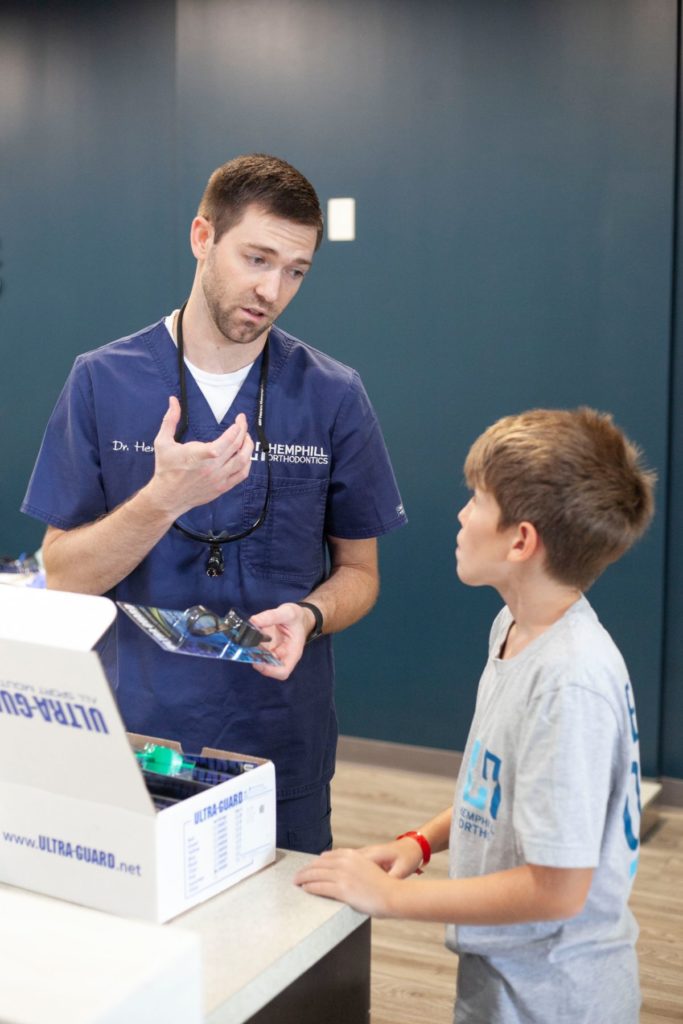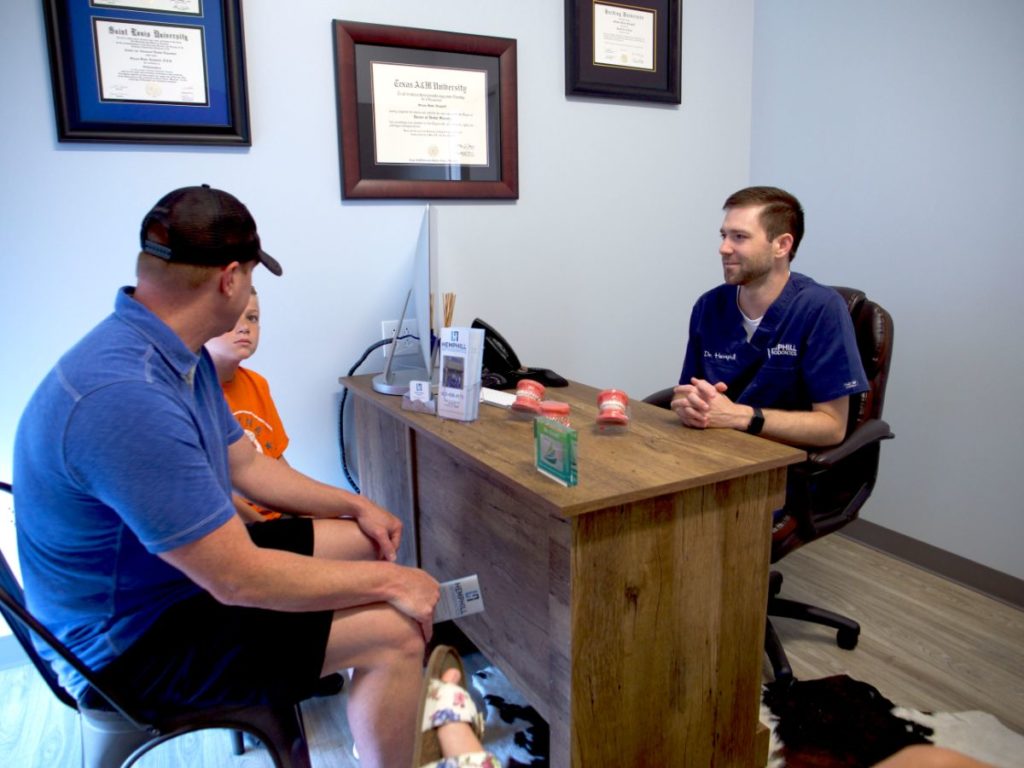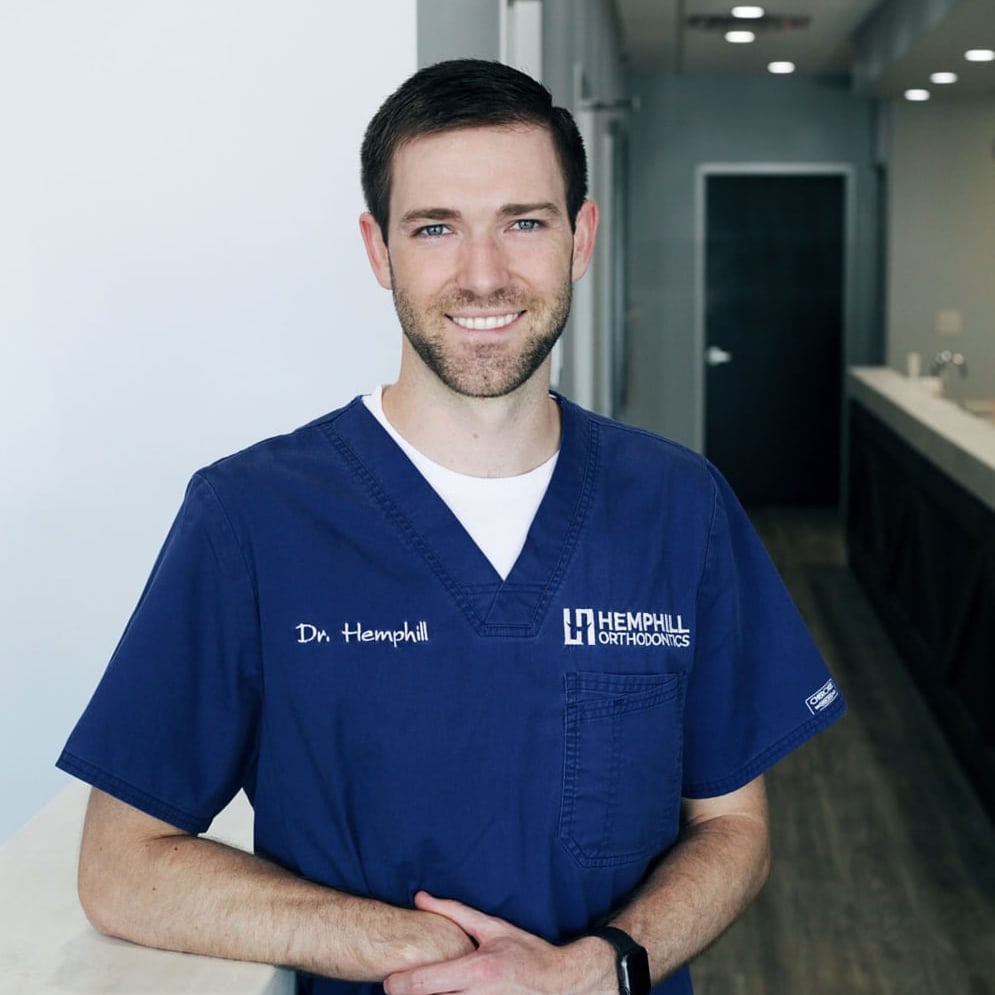As a parent or caregiver, you’re probably already familiar with the importance regular dental care has when it comes to giving your child a healthy smile. However, you may not be aware of the recommendation by the American Association of Orthodontists that says all children should have an initial orthodontic evaluation around the age of 7.
Many parents are confused by this recommendation at first, especially since most children that age still have developing mouths with a number of baby teeth present. Early evaluations are actually an essential part of the proactive approach we take to treatment here at Hemphill Orthodontics! They aren’t always followed by early treatment, but it gives us the chance to monitor a child’s growth patterns over the years.
That said, there will still be certain cases where intervention is required at a young age in order to obtain the most optimal results. This is because some orthodontic problems, if caught early, can be corrected before they develop into bigger problems later! Our expert team is committed to providing families with trusted information on what long-term orthodontic care might look like for their child, and two-phase treatment is sometimes a part of that plan. To learn more about how this method can give younger patients the best chance at a healthy smile, keep reading below!
Early orthodontic evaluations with Hemphill Orthodontics
An early evaluation gives us the opportunity to find, diagnose, and treat a number of common orthodontic issues before they have the chance to become more serious. This can also reduce the need for more intensive orthodontic treatment later on in life.
Every child’s orthodontic journey will begin with an initial evaluation. At our office, we’re pleased to provide this consultation free of charge! By the age of 6 or 7, when the AAO recommends children have their first orthodontic exam, most kids will usually have a mix of permanent and baby teeth. Dr. Hemphill will take a look at these teeth and other developmental markers to gain some insight into their alignment. This exam will also help him determine if there’s enough room in the mouth for all the permanent teeth to grow in comfortably.
What is two-phase treatment?
If Dr. Hemphill believes your young child would benefit from orthodontic care, he may recommend using two phases of treatment that are designed to be proactive rather than reactive.
With two-phase treatment, a child will receive orthodontic treatment in two different stages, with a period of rest in between. We’ll usually initiate the first phase when the child still has a good mix of primary and permanent teeth. We’ll follow this up with a period of no treatment, then begin the second phase after all or most of the adult teeth have emerged.
Two-phase treatment allows us to create a better environment for a child’s permanent teeth to grow into. This gives them the best start possible for a fully functional smile that looks and feels great! The two distinct phases of treatment help us build an optimal oral environment by:
- creating a more harmonious relationship between the teeth and jaws
- aligning the teeth, resulting in a straighter smile
- positioning the teeth and jaws for more pleasing facial symmetry
Who is a good candidate for two-phase treatment?
When you schedule your child’s first visit with Dr. Hemphill, he will perform a thorough oral examination, inspecting their mouth, teeth, and jaws. If any of the following issues are a concern, he may recommend two-phase treatment.
- Your child shows signs of a particular problem that we want to keep from developing (preventive treatment).
- Your child already has a developing problem that we now want to intercept (interceptive treatment).
- Your child’s jaw bones appear to need a bit of guidance as they grow (growth modification).
By following the normal patterns of childhood growth and development, Dr. Hemphill has the best chance to improve and correct orthodontic issues at the most opportune time. Many common problems that can be easily treated in a growing child become more complex to correct as they age and the jaw bones stop growing.
Phase 1 treatment
Phase 1 treatment can help a child’s jaws develop in a way that better accommodates all the permanent teeth, and can also improve the way the upper and lower jaws fit together. This has a number of benefits for growing children, ranging from an improved ability to bite and chew to an improved sense of self-confidence. Phase 1 treatment may also reduce the risk of tooth damage due to crowding, misalignment, or malformed jaws.
Children experiencing any of the following issues may be good candidates for Phase 1 treatment.
- Crooked or crowded
- Teeth with a noticeable gap
- Protruding teeth
- Teeth that don’t come together correctly
- Oral habits that may affect their dental development
- Speech problems
- Jaw out of proportion to the rest of the head
- Incoming permanent teeth that are being obstructed by baby teeth
Phase 1 treatment often provides lasting results. In certain cases, it can even lessen the impact of other problems. However, most patients will still require a second phase of treatment in order to complete the full process of alignment.
The rest period
Once the first phase of treatment has been successfully completed, the remaining permanent teeth should have a clear path to erupt. At this point, we will normally stop any active orthodontic treatment to give the teeth and jaws a break while the adult teeth make their way through the gums. We can keep the teeth stable during this rest period by using a space maintainer or a retainer.
Phase 2 treatment
We’ll normally initiate Phase 2 treatment once most or all of the permanent teeth have erupted. This is when all your child’s treatment begins to come together! Braces or clear aligners are often used to achieve the alignment we want, and once this phase is complete, we’ll use a fixed or removable retainer to ensure long-lasting results. Retainers are what keep the teeth in their new and improved positions over time.
Find your child’s best smile at Hemphill Orthodontics
At Hemphill Orthodontics, we believe that every smile is beautifully unique. What works for one child will not necessarily work for another, and that’s why our team is committed to creating individual and customized treatment plans for each patient we see. These plans are built around the specific needs and goals of that patient to provide the best possible outcome!
If your child is the recommended age for their first orthodontic visit, we’d love to meet you both and take a look at how everything is progressing. Get in touch with us today to schedule a FREE consultation and give your child the gift of a healthy smile!
 972-636-4175
Free Consult
972-636-4175
Free Consult



 Dr. Hemphill
Dr. Hemphill